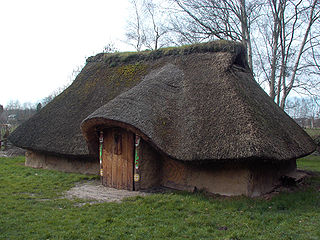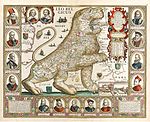
Ambiorix was, together with Cativolcus, prince of the Eburones, leader of a Belgic tribe of north-eastern Gaul, where modern Belgium is located. In the nineteenth century Ambiorix became a Belgian national hero because of his resistance against Julius Caesar, as written in Caesar's Commentarii de Bello Gallico.

This article concerns the period 59 BC – 50 BC.
Year 54 BC was a year of the pre-Julian Roman calendar. At the time, it was known as the Year of the Consulship of Appius and Ahenobarbus. The denomination 54 BC for this year has been used since the early medieval period, when the Anno Domini calendar era became the prevalent method in Europe for naming years.
Year 57 BC was a year of the pre-Julian Roman calendar. Contemporaneously, in the Roman Republic, it was known as the Year of the Consulship of Lentulus and Metellus. The denomination 57 BC for this year has been used since the early medieval period, when the Anno Domini calendar era became the prevalent method in Europe for naming years.

The Gallic Wars were waged between 58 and 50 BC by the Roman general Julius Caesar against the peoples of Gaul. Gallic, Germanic, and Brittonic tribes fought to defend their homelands against an aggressive Roman campaign. The Wars culminated in the decisive Battle of Alesia in 52 BC, in which a complete Roman victory resulted in the expansion of the Roman Republic over the whole of Gaul. Though the collective Gallic armies were as strong as the Roman forces, the Gallic tribes' internal divisions eased victory for Caesar. Gallic chieftain Vercingetorix's attempt to unite the Gauls under a single banner came too late. Caesar portrayed the invasion as being a preemptive and defensive action, but historians agree that he fought the wars primarily to boost his political career and to pay off his debts. Still, Gaul was of significant military importance to the Romans. Native tribes in the region, both Gallic and Germanic, had attacked Rome several times. Conquering Gaul allowed Rome to secure the natural border of the river Rhine.
Titus Labienus was a high-ranking military officer in the late Roman Republic. He served as tribune of the Plebs in 63 BC. Although mostly remembered as one of Julius Caesar's best lieutenants in Gaul and mentioned frequently in the accounts of his military campaigns, Labienus chose to oppose him during the Civil War and was killed at Munda. He was the father of Quintus Labienus.

The Nervii were one of the most powerful Belgic tribes of northern Gaul at the time of its conquest by Rome. Their territory corresponds to the central part of modern Belgium, including Brussels, and stretched southwards into French Hainault. During their first century BC Roman military campaign, Julius Caesar's contacts among the Remi stated that the Nervii were the most warlike of the Belgae. In times of war, they were known to trek long distances to take part in battles. Being one of the northerly Belgic tribes, with the Menapii to the west, and the Eburones to their east, they were considered by Caesar to be relatively uncorrupted by civilization. According to Tacitus they claimed Germanic descent. According to Strabo they were of Germanic origin.

The Battle of the Sabis, also known as the Battle of the Sambre or the Battle against the Nervians, was fought in 57 BC near modern Saulzoir in Northern France, between Caesar's legions and an association of Belgae tribes, principally the Nervii. Julius Caesar, commanding the Roman forces, was surprised and nearly defeated. According to Caesar's report, a combination of determined defence, skilled generalship, and the timely arrival of reinforcements allowed the Romans to turn a strategic defeat into a tactical victory. Few primary sources describe the battle in detail, with most information coming from Caesar's own report on the battle from his book, Commentarii de Bello Gallico. Little is therefore known about the Nervii perspective on the battle.

The Belgae were a large confederation of tribes living in northern Gaul, between the English Channel, the west bank of the Rhine, and the northern bank of the river Seine, from at least the third century BC. They were discussed in depth by Julius Caesar in his account of his wars in Gaul. Some peoples in southern Britain were also called Belgae and had apparently moved from the continent. T. F. O'Rahilly believed that some had moved further west and he equated them with the Fir Bolg in Ireland. The Roman province of Gallia Belgica was named after the continental Belgae. The term continued to be used in the region until the present day and is reflected in the name of the modern country of Belgium.

The Menapii were a Belgic tribe dwelling near the North Sea, around present-day Cassel, during the Iron Age and the Roman period.

The Tungri were a tribe, or group of tribes, who lived in the Belgic part of Gaul, during the times of the Roman Empire. Within the Roman Empire, their territory was called the Civitas Tungrorum. They were described by Tacitus as being the same people who were first called "Germani" (Germanic), meaning that all other tribes who were later referred to this way, including those in Germania east of the river Rhine, were named after them. More specifically, Tacitus was thereby equating the Tungri with the "Germani Cisrhenani" described generations earlier by Julius Caesar. Their name is the source of several place names in Belgium, Germany and the Netherlands, including Tongeren, Tongerlo Abbey, and Tongelre.

The Eburones were a Gaulish-Germanic tribe dwelling in the northeast of Gaul, who lived north of the Ardennes in the region near that is now the southern Netherlands, eastern Belgium and the German Rhineland, in the period immediately preceding the Roman conquest of the region. Though living in Gaul, they were also described as being both Belgae and Germani.

The Atuatuci were a Gallic-Germanic tribe, dwelling in the eastern part of modern-day Belgium during the Iron Age.

The Battle of the Axona was fought in 57 BC, between the Roman army of Gaius Julius Caesar and the Belgae. The Belgae, led by King Galba of the Suessiones, attacked, only to be repelled by Caesar. Fearing an ambush, the Romans delayed their pursuit. Caesar's Commentarii de Bello Gallico describes this battle at 2.7 - 2.11.
Atuatuca is the name of two ancient fortified settlements located in the eastern part of modern Belgium, between the Scheldt and Rhine rivers. The oldest one, Atuatuca Eboronum, attested during the Gallic Wars, was the stronghold of the Eburones. The other one, Atuatuca Tungrorum, founded around 10 BC, was the Roman-era capital of the Civitas Tungrorum, inhabited by the Tungri.
Quintus Titurius Sabinus was one of Caesar's legates during the Gallic Wars. He is first mentioned in Caesar's campaign against the Remi, in 57 BC. In 56 BC, he was sent by Caesar with three legions against the Venelli, Curiosolitae, and Lexovii, who were led by Viridovix. He gained a great victory over Viridovix's forces, and all the insurgent states submitted to his authority.
Lucius Aurunculeius Cotta was an officer in the Gallic army of Gaius Julius Caesar. The little we know of Cotta is found in Book V of Caesar's De Bello Gallico. In 54 BC, when Caesar returned to Gaul from his second expedition to Britain, he found food in short supply. He therefore spread out his eight legions amongst a larger number of Gallic states from which to draw their sustenance during the winter. To the eighth legion, which had recently been raised from across the Po he added another five cohorts, appointing Quintus Titurius Sabinus and Lucius Aurunculeius Cotta as the legati commanding them.
Indutiomarus was a leading aristocrat of the Treveri at the time of Julius Caesar's conquest of Gaul. He was the head of the anti-Roman party and the political rival of his pro-Roman son-in-law Cingetorix for "supreme power" in the state.
The Germani cisrhenani, or "Left bank Germani", were a group of Germanic peoples who lived west of the Lower Rhine at the time of the Gallic Wars in the mid-1st century BC.

The Civitas Tungrorum was a large Roman administrative district dominating what is now eastern Belgium and the southern Netherlands. In the early days of the Roman Empire it was in the province of Gallia Belgica, but it later joined the neighbouring lower Rhine River border districts, within the province of Germania Inferior. Its capital was Aduatuca Tungrorum, now Tongeren.













